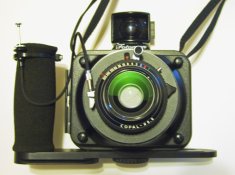Tom Stanworth
Member
- Joined
- Sep 4, 2003
- Messages
- 2,021
- Format
- Multi Format
with the release of the Fotoman 69, std and shift, there is now a point and shoot competitor to the Alpa, which takes a variety of LF lenses and backs. so my question is this:
Alpa prices are astounding and I have no doubt that the compenents are beautifully made. My question is to what end. I have heard that Alpa film backs are made to much higher tolerances and that film flatness is supposed to be better than with Horseman or Wista backs (is it really?). I am curious as to whether this makes any difference in the real world, especially considering that few Alpas are used wide open and I presume (maybe I am wrong) that most are stopped down moderately to make the use of scale focused lenses more practical. I am sure some use them off a tripod with ground glass backs, but suspect this is the minority.
I owned a Fotoman 612 and regret selling it. It was solid and well machined, but the tolerances were probably less perfect than an Alpa; however, the trannies were incredibly detailed. The new 69 from Fotoman allows the use of ultra wide lenses such a the 38XL on 6x9 format - something no other point and shoot/RF offered apart from the Alpa - which is appreciably wider than even the 43mm on a Mamiya 7 6x7 neg. One could also potentially use digital backs and digitar lenses if required.
I would be interested to know if the extra expense of the Alpa (I am not buying one because I cannot!) has any real functionality now that a camera is available that allows use of the same lenses, in all likelihood to the same end for a tiny fraction of the price. I realise the Alpa is a beautiful bit of kit, but at about $12/13K for one single camera and lens, back and finder (without shift) and no longer on unique turf, it looks less sensible than ever before. The grip on the new Fotoman looks less ergonomically comfortable, but still...at $9,500 less for a 6x9 with a 38/47XL, I am sure most could live with that and I suspect the results on film are indistinguishable.
If the fotoman 69 is like the 612, solidity is not an issue with the body.
well done Fotoman!
Alpa prices are astounding and I have no doubt that the compenents are beautifully made. My question is to what end. I have heard that Alpa film backs are made to much higher tolerances and that film flatness is supposed to be better than with Horseman or Wista backs (is it really?). I am curious as to whether this makes any difference in the real world, especially considering that few Alpas are used wide open and I presume (maybe I am wrong) that most are stopped down moderately to make the use of scale focused lenses more practical. I am sure some use them off a tripod with ground glass backs, but suspect this is the minority.
I owned a Fotoman 612 and regret selling it. It was solid and well machined, but the tolerances were probably less perfect than an Alpa; however, the trannies were incredibly detailed. The new 69 from Fotoman allows the use of ultra wide lenses such a the 38XL on 6x9 format - something no other point and shoot/RF offered apart from the Alpa - which is appreciably wider than even the 43mm on a Mamiya 7 6x7 neg. One could also potentially use digital backs and digitar lenses if required.
I would be interested to know if the extra expense of the Alpa (I am not buying one because I cannot!) has any real functionality now that a camera is available that allows use of the same lenses, in all likelihood to the same end for a tiny fraction of the price. I realise the Alpa is a beautiful bit of kit, but at about $12/13K for one single camera and lens, back and finder (without shift) and no longer on unique turf, it looks less sensible than ever before. The grip on the new Fotoman looks less ergonomically comfortable, but still...at $9,500 less for a 6x9 with a 38/47XL, I am sure most could live with that and I suspect the results on film are indistinguishable.
If the fotoman 69 is like the 612, solidity is not an issue with the body.
well done Fotoman!











